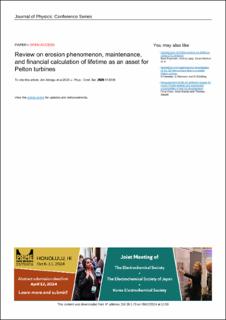Review on erosion phenomenon, maintenance, and financial calculation of lifetime as an asset for Pelton turbines
Peer reviewed, Journal article
Published version

Åpne
Permanent lenke
https://hdl.handle.net/11250/3115886Utgivelsesdato
2023Metadata
Vis full innførselSamlinger
- Publikasjoner fra CRIStin - NINA [2364]
- Scientific publications [1392]
Originalversjon
Journal of Physics: Conference Series (JPCS). 2023, 2629 . 10.1088/1742-6596/2629/1/012008Sammendrag
Prevention of greenhouse emissionsis the top priority for all countries, which urges them to switch to renewable energy as much as possible. Hydropower is one of the renewables that have high flexibility and at the same time compatibility to be used with any other renewable sources. Moreover, hydropower plants operating in the Himalayas, Andes, and Alps are facing operational challenges due to the high concentration of sediment loads in rivers. Although the arrangement of traditional sediment control mechanisms like dams and sand traps, the erosion tendency of hydroturbine components operating in this sediment-laden water increases with the increased concentration of sediments. Much past research has been directed towards understanding sediment behaviors, investigation of flow, and effect of concentration, shape, and size, especially with Francis turbines. However, there are very fewer studies regarding sediment erosion and flow behavior in the case of the Pelton turbine. Hence, delving deeper into the flow characteristics, sediment behavior, and performance of the Pelton turbine is important to better understand the flow and sediment pattern of these types of turbines. The paper consists of the evaluation of studies conducted on the flow pattern in the Pelton turbine buckets and its validation with the numerical analysis models using image processing. It is being used in the Waterpower Laboratory at the Norwegian University of Science and Technology, NTNU. This paper also evaluates the scope of investigations about erosion by sediments in Pelton buckets using image analysis and state-of-the-art technology in the hydropower sector. In addition, a review is done about the predictability of erosion based on the measurements of the quantity of sediments that passes through the turbine. This research paper can build a background for quantifying sediment erosion in Pelton turbines with a certain degree of error, which can be utilized as a reference in future studies. The life cycle estimation of a turbine is also analyzed with the consideration of its location and financial return requirements together with the type of maintenance that it may have and the repair that is foreseen, in the case of a non-coated surface. Erosion, Flow behavior, Image analysis, Pelton turbine, Sediment particles
